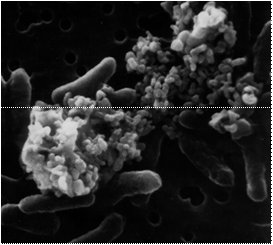Environmental Geochemistry and Biogeochemistry
Characterizing the distribution and transformation of inorganic contaminants in the environment (Kostka, Taillefert)
Trace metals are inorganic contaminants that accumulate in both terrestrial and aquatic environments as a result of industrial activities. Research in EAS focuses on elucidating the fundamental chemical and biological processes that determine the fate and transport of inorganic contaminants. Results from these basic science approaches may be used to develop new strategies and predictive models for the remediation of inorganic contaminants in the environment.
Microorganisms mediate critical biogeochemical processes that limit the fate of inorganic contaminants. Thus, the active microbial groups responsible for contaminant transformation are explored by coupling state-of-the-art molecular biology techniques to to the isolation and characterization of new organisms with a high bioremediation potential (Kostka). In particular, EAS studies focus on the global scale problem of radioactive metal contamination in the subsurface of nuclear legacy waste sites. Microbes capable of immobilizing metal contaminants such as uranium are enriched, isolated, and purified from the contaminated subsurface. These strains are then investigated for their ability to immobilize uranium either via bioreduction or the biomineralization of uranium phosphate minerals (Taillefert).
Second, the distribution and transformation of other toxic metals of societal relevance, such as arsenic, lead, or copper is investigated either in the field or in the laboratory with model metal-reducing microorganisms (Taillefert). The objective of this work is to understand how microbes deal with toxic metals and how these metals affect metabolic processes.
Characterizing the microbial processes regulating the transformation of nutrients and metals in terrestrial and marine environments (Glass, Ingall , Kostka, Taillefert)

Manganese, iron, and other trace metals represent essential elements for microbial processes. Yet, the molecular pathways regulating the transformation of these elements by microorganisms remain poorly understood. Research in EAS attempts to characterize these processes using molecular approaches.
First the molecular pathways of manganese and iron reduction during their anaerobic respiration by metal-reducing bacteria are investigated in collaboration with Tom DiChristina from the School of Biology (Tom DiChristina; Taillefert) to understand how microorganisms have evolved pathways that exploit metals as source of energy. Interestingly, the same microorganisms are also able to transform toxic metals and could be exploited in bioremediation studies or biofuel energy generation (Kostka).
Second, the role of trace metal bioavailability on the growth of microorganisms involved in the transformation of bioessential elements (such as carbon, nitrogen, and sulfur) and greenhouse gases (methane and nitrous oxide) on Earth is investigated (Glass). Simultaneously, the link between metal bioavailability and microorganism physiology is investigated using state-of-the-art synchrotron X-ray microimaging techniques (Ingall) and nano-scale masss spectrometric techniques (Glass). The objective of this research is to understand how metal limitations in the environment shape the evolution of microorganisms, their natural products, and, ultimately, biogeochemical processes on Earth.
Characterizing the distribution and transformation of metals in atmospheric aerosols (Ingall)

Exposure to reactive oxygen species (ROS) in atmospheric urban aerosols has been linked to negative health impacts (e.g. cardiovascular disease and acute heart disease). Redox cycling of water-soluble metals in aerosols, such as iron, is thought to be a major formation pathway of ROS. In order to improve the assessment of water-soluble iron (WS_Fe) on health impacts, collaborative research between the geochemistry and atmospheric groups (Weber link) at Georgia Tech is investigating the factors that affect iron solubility in atmospheric aerosols. Synchrotron-based technology, such as X-ray Absorbance Near-Edge Structure spectroscopy and micro-X-ray fluorescence are used to characterize a variety of chemical properties, such as oxidation state, mineralogy, and elemental composition, in single aerosol particles. When used in conjunction with metal solubility measurements, these techniques can provide key insights into the chemical and/or physical properties controlling metal solubility that are necessary to understand environmental impacts associated with metals in aerosols.
Characterizing the composition of natural organic matter in aquatic systems (Perdue)

Riverine dissolved and particulate organic matter is a significant source of organic carbon to continental margins. The processes regulating the distribution and transformation of natural organic matter in aquatic environments are not well known. In the geochemistry group, researchers currently study the formation and transformation of natural organic matter in freshwater and marine environments (Perdue). Their main objective is to determine the physico-chemical properties of terrestrially- and marine-derived natural organic matter and study their reactivity.